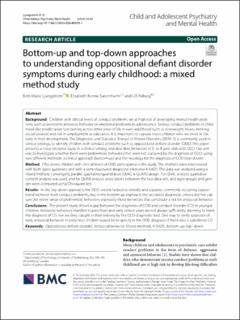| dc.contributor.author | Ljungström, Britt-Marie | |
| dc.contributor.author | Kenne Sarenmalm, Elisabeth | |
| dc.contributor.author | Axberg, Ulf | |
| dc.date.accessioned | 2020-11-05T08:30:03Z | |
| dc.date.available | 2020-11-05T08:30:03Z | |
| dc.date.created | 2020-09-16T12:42:15Z | |
| dc.date.issued | 2020 | |
| dc.identifier.citation | Child and Adolescent Psychiatry and Mental Health (CAPMH). 2020, 14 (1), 1-14. | en_US |
| dc.identifier.issn | 1753-2000 | |
| dc.identifier.uri | https://hdl.handle.net/11250/2686492 | |
| dc.description.abstract | Background: Children with clinical levels of conduct problems are at high risk of developing mental health prob lems such as persistent antisocial behavior or emotional problems in adolescence. Serious conduct problems in child hood also predict poor functioning across other areas of life in early adulthood such as overweight, heavy drinking, social isolation and not in employment or education. It is important to capture those children who are most at risk, early in their development. The Diagnostic and Statistical Manual of Mental Disorders (DSM–5) is commonly used in clinical settings, to identify children with conduct problems such as oppositional defant disorder (ODD).This paper presents a cross-sectional study in a clinical setting, and describes behaviors in 3- to 8-year-olds with ODD. Our aim was to investigate whether there were problematic behaviors that were not captured by the diagnosis of ODD, using two diferent methods: a clinical approach (bottom-up) and the nosology for the diagnosis of ODD (top-down).
Method: Fifty-seven children with clinical levels of ODD participated in the study. The mothers were interviewed with both open questions and with a semi-structured diagnostic interview K-SADS. The data was analyzed using a mixed method, convergent, parallel qualitative/quantitative (QUAL+QUAN) design. For QUAL analysis qualitative content analysis was used, and for QUAN analysis associations between the two data sets, and ages-groups and gen der were compared using Chi-square test.
Results: In the top-down approach, the ODD criteria helped to identify and separate commonly occurring opposi tional behavior from conduct problems, but in the bottom-up approach, the accepted diagnostic criteria did not cap ture the entire range of problematic behaviors-especially those behaviors that constitute a risk for antisocial behavior.
Conclusions: The present study shows a gap between the diagnoses of ODD and conduct disorder (CD) in younger children. Antisocial behaviors manifest in preschool and early school years are not always sufciently alarming to meet the diagnosis of CD, nor are they caught in their entirety by the ODD diagnostic tool. One way to verify suspicion of early antisocial behavior in preschool children would be to specify in the ODD diagnosis if there also is subclinical CD. | en_US |
| dc.language.iso | eng | en_US |
| dc.publisher | BioMed Central | en_US |
| dc.subject | bottom–up-top–down | en_US |
| dc.subject | K-SADS | en_US |
| dc.subject | mixed methods | en_US |
| dc.subject | antisocial behavior | en_US |
| dc.subject | oppositional defant disorder | en_US |
| dc.title | Bottom-up and top-down approaches to understanding oppositional defiant disorder symptoms during early childhood: a mixed method study | en_US |
| dc.type | Peer reviewed | en_US |
| dc.type | Journal article | en_US |
| dc.description.version | publishedVersion | en_US |
| dc.rights.holder | Open Access | en_US |
| dc.source.pagenumber | 1-14 | en_US |
| dc.source.volume | 14 | en_US |
| dc.source.journal | Child and Adolescent Psychiatry and Mental Health (CAPMH) | en_US |
| dc.source.issue | 1 | en_US |
| dc.identifier.doi | 10.1186/s13034-020-00339-1 | |
| dc.identifier.cristin | 1830420 | |
| cristin.ispublished | true | |
| cristin.fulltext | original | |
| cristin.qualitycode | 1 | |
